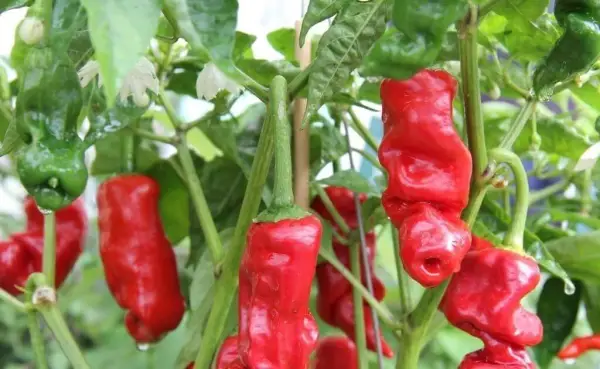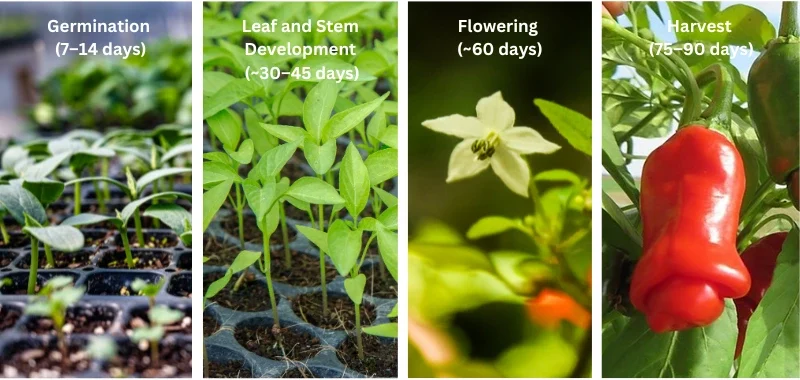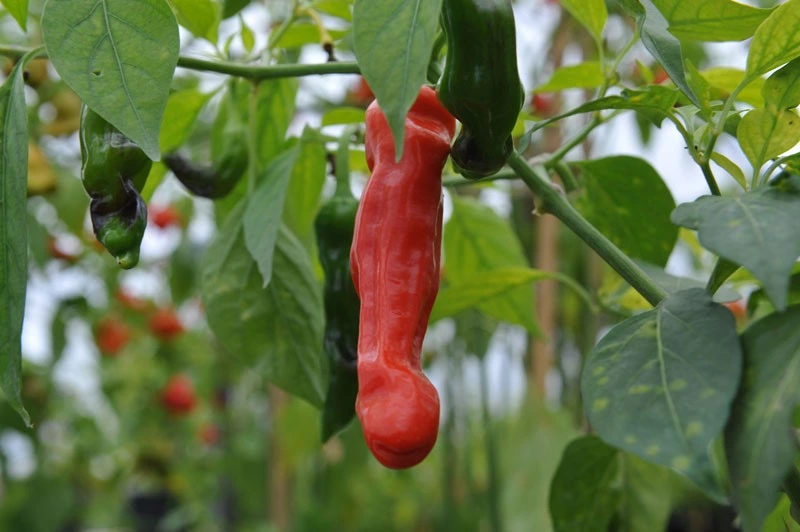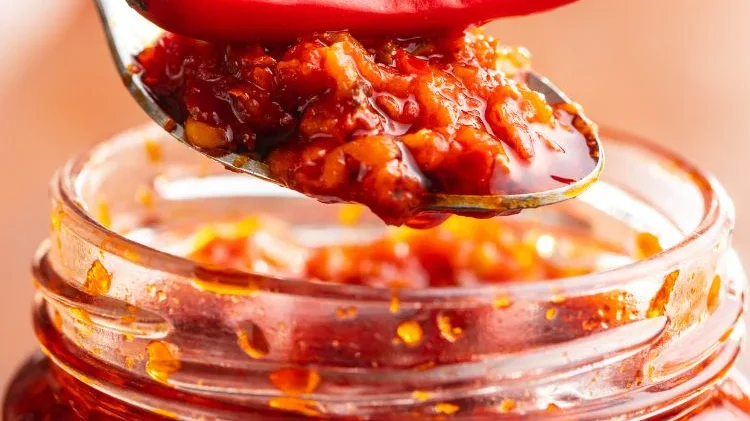If you’ve been searching for a unique and spicy addition to your garden, Peter Pepper Plants might just be the perfect fit. Their unusual shape, hot flavor, and novelty make them a favorite among gardening enthusiasts. With their quirky shape, vibrant colors, and spicy kick, these peppers are perfect for adding charm to your garden or spice to your plate. But how do you grow these peppers successfully? Let’s dive into everything you need to know about planting, caring for, and harvesting Peter Pepper Plants.
What Are Peter Pepper Plants?

Peter Pepper Plants (scientifically known as Capsicum annuum) are a rare variety of chili peppers.
If you’re new to gardening, you might wonder, “What makes Peter Peppers so special?” Well, these chili peppers (Capsicum annuum) stand out not only for their unusual shape, which resembles a certain part of the anatomy but also for their medium heat and bold flavor.
The Peter Pepper packs a punch at about 6 times hotter than a Chile Pequin, sitting between 5,000 to 30,000 on the Scoville Scale, depending on the variety. Its heat level is comparable to a Peach Ghost Pepper, but its texture is less dense and meaty, making it an excellent choice for drying as well as for fresh preparation.
Read more: How to Grow Peach Ghost Pepper Plants
They’re often grown as a novelty or conversation piece, but their uses go beyond aesthetics.
The Peter Pepper is famous more for its striking appearance than its flavor. Its unusual shape, resembling a certain anatomical feature, makes it a quirky and humorous addition to any garden. In fact, its remarkable resemblance has even earned it the title of the “Most Pornographic Pepper”!
Fun Fact: Peter Peppers can range in color from green to vibrant red, orange, or yellow when ripe, making them a colorful addition to any garden.
Key Features of Peter Pepper Plants
-
Spice Level: Medium to high heat, typically 5,000–30,000 Scoville units (not 10,000–23,000).
-
Mature Size: 2–3 feet tall, 1–2 feet wide (they tend to grow a bit taller than originally stated).
-
USDA Growing Zones: 9–11 (can be grown as an annual in cooler zones or in pots for indoor care).
-
Ideal Growing Conditions: Warm, sunny climates with well-draining, nutrient-rich soil.
-
Expected Planting Period: Spring, after the last frost date.
-
Growth Rate: Moderate growth during the growing season with proper care.
-
Growth Habit: Bushy plants with a compact shape that grow up to 2–3 feet tall.
-
Fruit Appearance: Curved and elongated, with a knobby and unique, anatomical appearance.
Planting Peter Pepper Plants
1. Choosing the Right Location
Peter Peppers are sun-lovers. If you’ve got a sunny spot in your yard or on your balcony that gets 6–8 hours of direct sunlight, you’re golden. If you don’t, consider investing in a grow light for indoor gardening.
2. Soil Preparation
Healthy soil is the foundation of any successful plant. Don’t worry, though—it’s not as complicated as it sounds.
What You’ll Need:
- Well-draining soil (you can buy this at any gardening store).
- Compost or organic matter to boost nutrients.
How to Test Soil:
- Stick your finger into the soil. If it feels crumbly and not sticky, it’s good to go.
- Ideally, the soil’s pH should be slightly acidic, between 6.0 and 6.8. Don’t stress if you don’t have a pH kit—most potting mixes are pre-balanced.
3. Planting Seeds or Transplants
Starting with Seeds (For the Patient Gardener)
-
Why Choose Seeds? It’s cheaper and gives you more control.
-
Start indoors 6–8 weeks before your last frost date.
-
Use small containers or seed trays. Plant seeds about 1/4 inch deep in moist soil.
-
Keep the temperature warm—between 75°F and 85°F. A sunny windowsill works wonders, but a heat mat can also help.
Using Transplants (For a Head Start)
-
If you’d rather skip the germination process, buy young plants from a nursery.
-
Harden off seedlings by gradually exposing them to outdoor conditions for a week before planting.
-
After the last frost, plant them in your garden or containers, spacing them about 18–24 inches apart.

4. Container Planting Tips
If you’re short on space or prefer portability, containers are your best friend.
-
Pick the Right Pot: Go for one that’s at least 12 inches wide and deep, with drainage holes.
-
Choose the Right Spot: Place the pot in a sunny area or under grow lights.
-
Tip for Beginners: Keep the soil moist but not soggy. Overwatering is a common rookie mistake!
Read more: How to Grow Chili Peppers in Containers
How to Grow Peter Pepper Plants
1. Watering
-
Water regularly, especially during dry spells.
-
Avoid soaking the leaves—wet leaves can lead to diseases.
2. Fertilizing
-
Use a balanced fertilizer (10-10-10 works well) every few weeks during the growing season.
-
Switch to a phosphorus-rich fertilizer once you see flowers to encourage fruiting.
3. Mulching
-
Spread a layer of organic mulch, like straw or shredded leaves, around the base of the plant. This keeps the soil moist and prevents weeds.
4. Pruning and Maintenance
-
Trim away any yellowing or dead leaves to keep your plant healthy.
-
Pinching off the first few flowers helps the plant grow stronger in the long run.
Common Problems and How to Solve Them
-
Pests: Aphids, spider mites, and whiteflies can attack Peter Peppers. Use insecticidal soap or neem oil as needed.
-
Diseases: Prevent fungal issues like powdery mildew by avoiding overhead watering and ensuring proper spacing.
-
Slow Growth: Ensure your plants get enough sunlight and nutrients.
Growing Peter Peppers Indoors (Yes, It’s Possible!)
If outdoor gardening isn’t an option, you can grow Peter Pepper Plants indoors with the right setup. Not everyone has a garden, but don’t let that stop you! Here’s how to grow Peter Peppers indoors:
1. Choose the Right Pot and Soil
-
Use a pot at least 12 inches in diameter with drainage holes.
-
Opt for a lightweight potting mix with added organic matter.
2. Provide Adequate Light
-
Place the pot near a south-facing window or use grow lights for 12–16 hours daily.
3. Control Temperature and Humidity
-
Maintain indoor temperatures between 70–85°F.
-
Use a humidifier if your home is dry.
4. Water and Fertilize Consistently
-
Water when the top inch of soil feels dry.
-
Fertilize with a balanced liquid fertilizer every 2–3 weeks.
5. Prune and Pollinate
-
Trim excess foliage to focus energy on fruit production.
-
Hand-pollinate flowers using a small brush or by gently shaking the plant.
Tips for Harvesting Peter Peppers Successfully.

Peter Peppers are ready to harvest about 75–90 days after planting. Look for fully developed peppers with bright red, orange, or yellow hues. Use scissors or pruning shears to avoid damaging the plant.
Here comes the fun part! Peter Peppers are usually ready to harvest about 75–90 days after planting.
-
When to Harvest:
-
Look for bright red, orange, or yellow colors depending on the variety.
-
Peppers should feel firm to the touch.
-
-
Harvesting Method:
-
Use scissors or pruning shears to cut peppers cleanly, leaving a bit of stem.
-
Avoid pulling peppers by hand to prevent damaging the plant.
-
-
Post-Harvest Storage:
-
Store fresh peppers in a cool, dry place for up to a week.
-
Freeze excess peppers whole or sliced for long-term use.
-
Top Recipes with Peter Peppers

Peter Peppers aren’t just a conversation starter—they’re delicious too!
-
Peter Pepper Hot Sauce
-
Ingredients: Peter Peppers, garlic, vinegar, salt, and a touch of sugar.
-
Instructions: Blend roasted peppers with garlic and vinegar, simmer to thicken, and store in sterilized bottles.
-
Perfect for tacos, marinades, or drizzling over eggs.
-
-
Quick Pickled Peter Peppers
-
Ingredients: Sliced peppers, white vinegar, water, sugar, and salt.
-
Instructions: Heat vinegar with sugar and salt, pour over peppers in a jar, and refrigerate.
-
Use them in salads, burgers, or sandwiches.
-
-
Grilled Peter Pepper Salsa
-
Roast peppers, onions, and tomatoes, then blend with lime juice and cilantro.
-
Great with chips or as a topping for grilled meats.
-
Have a favorite Peter Pepper recipe? Share it with us in the comments!
FAQs About Peter Pepper Plants
1. Can Peter Pepper Plants grow in colder climates?
Yes, Peter Pepper plants can grow in colder climates, but they require some extra care. Starting the seeds indoors 6–8 weeks before the last frost ensures they get a good head start. If frost is a concern, growing them in pots allows you to move them to a warmer spot or into a greenhouse. With proper temperature control and adequate sunlight, these plants can thrive even in regions with shorter growing seasons.
2. How spicy are Peter Peppers compared to other chili peppers?
Peter Peppers have a spice level that ranges from 5,000 to 30,000 Scoville units, placing them between jalapeños (2,500–8,000 SHU) and cayenne peppers (30,000–50,000 SHU). This makes them moderately hot but still manageable for most spice lovers. Their heat is enough to give a dish a kick, but it’s balanced by a subtle sweetness, making them great for adding flavor without overwhelming the palate.
3. How long do Peter Pepper Plants live?
In their native warm climates or with proper care, Peter Pepper plants are perennial and can live for several years, producing fruit year after year. In colder climates, they are often grown as annuals unless brought indoors during the winter. With the right conditions, including consistent warmth, sunlight, and care, these quirky plants can continue to provide spicy, amusing peppers for multiple seasons.
4. Are Peter Peppers edible?
Absolutely! Peter Peppers are not just a novelty; they’re also delicious. Their moderate heat and slightly fruity flavor make them perfect for salsas, hot sauces, and even pickling. They’re versatile in the kitchen and can be used fresh, dried, or ground into spice blends. Plus, they’re a great conversation starter when served at parties!
Conclusion
Growing Peter Pepper Plants is a rewarding and entertaining experience. Whether you’re adding a quirky touch to your garden or spicing up your meals, these unique peppers won’t disappoint. With the tips above, you’re all set to grow, care for, and enjoy these fiery gems. So why wait? Start planting your Peter Pepper Plants today! Ready to grow your own Peter Peppers? Check out Garden Plant Nursery for the best seeds available.
